Related Research Articles

The Mercedes-Benz M112 engine is a gasoline-fueled, 4-stroke, spark-ignition, internal-combustion automobile piston V6 engine family used in the 2000s. Introduced in 1996, it was the first V6 engine ever built by Mercedes. A short time later the related M113 V8 was introduced.
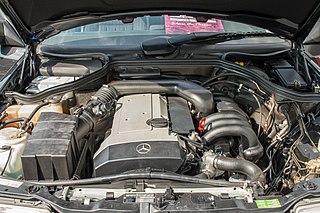
The Mercedes-Benz M104 is a automobile straight-six engine produced from 1988 through 1999. It has a double overhead cam design with 4 valves per cylinder, and used a crossflow cylinder head. It replaced the M103 and was replaced by the M112 V6 starting in 1997. The bore spacing on all M104 engines is the same as M103 engines.

The Mercedes-Benz W136 was Mercedes-Benz's main line of inline-four cylinder motorcars from the mid-1930s into the 1950s. The model 170 V made its public debut as successor to the W15 Typ 170 in February 1936. Between 1936 and 1939 it was Mercedes' top selling model.
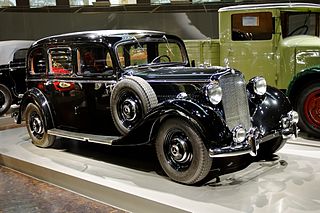
The Mercedes-Benz 260 D, coded Mercedes-Benz W 138 according to internal works designation, was one of the first three diesel engined series produced passenger cars, together with 1933 Citroën Rosalie 11UD and the diesel version of the Hanomag Rekord. The 260 D was named in reference to its engine's cubic capacity. Nearly 2,000 vehicles were assembled until 1940, after which the Daimler-Benz group had to devote itself almost entirely to military manufacture.

The Borgward Hansa 1500 is a medium-sized automobile manufactured by the Bremen based auto-manufacturer Carl F. W. Borgward GmbH from 1949 until 1954. It was first presented at the Geneva Motor Show in March 1949 and production commenced on 13 October 1949. The similar Hansa 1800 was introduced in 1952. The Hansa was replaced by the Borgward Isabella in 1954.

From 1931 to 1939, Daimler-Benz AG produced three cars with rear engine as well as a few prototypes. Production numbers remained low for each of these models, especially compared with the production of conventional front-engine Mercedes-Benz cars.

The Mercedes-Benz Mannheim 350 replaced the W03/Typ 350 models in 1929. The structure originated by Ferdinand Porsche was modified by Hans Nibel.

The Mercedes-Benz W15 is an automobile produced by Mercedes-Benz from 1931 to 1936. Regarded today as a mid-size family car, it was given the chassis designation W15, and sold as the Typ 170 in four-door "Limousine" (sedan/saloon) and Cabriolet forms.

The Mercedes-Benz 170 S is a luxury car which was produced by Mercedes-Benz from 1949 until 1955 in various gasoline and diesel powered forms. It was initially offered with a 1.8 liter version of the 1.7 liter inline-four cylinder M136 engine used in the slightly smaller production type 170 V. It was the first Mercedes-Benz to carry in its name the suffix “S” (for Sonder modell denoting a superior level of comfort and quality. As such, its intended market was successful business owners and company directors.

The Mercedes-Benz Typ 230 n was introduced by Mercedes-Benz in 1937 as a successor to the Typ 230 . It was one of several models over the space of nearly eight decades to be sold with a name along the lines "Mercedes-Benz 230", and is therefore in retrospect more normally named according to its internal works designation as the Mercedes-Benz W 143.
The Adler Standard 8 is a large passenger car introduced in 1928 by the Frankfurt auto-maker, Adler. It was a big eight cylinder “limousine” (saloon) closely modelled on the manufacturer’s Standard 6 which had first appeared in public in October 1926. However the Standard 8 had a longer 3,325 mm (130.9 in) wheelbase as well as a 50 mm (2.0 in) wider track. Although it closely resembled the Standard 6, the Standard 8 was larger all round. The Standard 8 engine had eight cylinders, but individually the cylinder dimensions, at 75 mm (3.0 in) x 110 mm (4.3 in), were identical to those on the six cylinder car as well as on the four cylinder with the Adler Favorit which appeared in 1929.
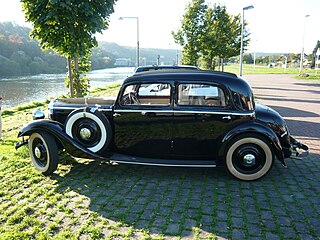
The Mercedes-Benz W 21 was a six-cylinder passenger car launched in 1933 using the name Mercedes-Benz Typ 200. It was one of several Mercedes-Benz models known, in its own time, as the Mercedes-Benz 200 and is therefore in retrospect more commonly referred to using its Mercedes-Benz works number, “W21”.

The Benz 10/25 PS was a midsize automobile introduced by Benz & Cie in 1912. The same year stated maximum output was increased which meant a name change to Benz 10/30 PS. The model disappeared for three years following the First World War but returned in 1921. A further power increase in 1926 meant another name change, now to Benz 10/35 PS. Following the "fusion" between the Daimler and Benz companies, production of the Benz 10/35 PS ended in 1927.
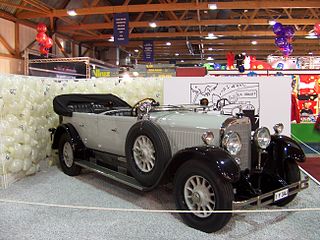
The Mercedes 15/70/100 PS was a large automobile introduced by Daimler in 1924. Production continued till 1929 by which time Daimler had merged with Benz & Cie as a result of which the car's name had changed to Mercedes-Benz Typ 400.

The Mercedes-Benz W02 was a midsize six-cylinder two-litre-engined automobile introduced by Daimler-Benz at the Berlin Motor Show in October 1926. It was developed in some haste under the manufacturer's Technical Director, Ferdinand Porsche in parallel with the smaller Mercedes-Benz W 01 and the larger three-litre-engined Mercedes-Benz W03 following the creation of Daimler-Benz, formally in July 1926, from the fusion of the Daimler and Benz & Cie auto-businesses.
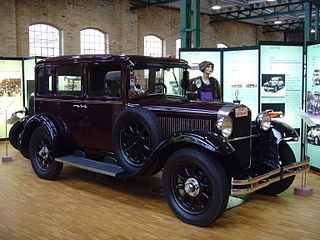
The Mercedes-Benz W11 was a midsize six-cylinder automobile introduced by Daimler-Benz it 1929. It was developed from the Mercedes-Benz W02 first seen in 1926, and the W11 shared its chassis and bodywork with the W02, but the W11 came with a larger more powerful engine, a new name and a wider list of “standard bodies” from which customers could choose.

The Mercedes-Benz W03 was a large six-cylinder-engined automobile introduced as the Mercedes-Benz 12/55 PS and, initially, as the Mercedes-Benz Typ 300, by Daimler-Benz at the Berlin Motor Show in October 1926. It was developed in some haste under the manufacturer's Technical Director, Ferdinand Porsche in parallel with the smaller Mercedes-Benz W 01 and the two-litre-engined Mercedes-Benz W02 following the creation of Daimler-Benz, formally in July 1926, from the fusion of the Daimler and Benz & Cie auto-businesses.
The Mercedes-Benz M23 engine is a naturally-aspirated, 1.3-liter, inline-4 gasoline engine, designed, developed and produced by Mercedes-Benz; between 1933 and 1936.
The Mercedes-Benz M21 engine is a naturally-aspirated, 2.0-liter, straight-6, internal combustion piston engine, designed, developed and produced by Mercedes-Benz; between 1933 and 1936.
The Mercedes-Benz M11 engine is a naturally-aspirated, 2.6-liter, straight-6, internal combustion piston engine, designed, developed and produced by Mercedes-Benz; between 1929 and 1935.
References
- ↑ "Mercedes-Benz M15 Engine". Sportlichleicht.com. Retrieved 10 November 2021.
- ↑ "Horsepower and Torque curve for 1931 Mercedes-Benz 170 (man. 4) offered since mid-year 1931 for Europe". Automobile-catalog.com. Retrieved 10 November 2021.
- ↑ "1934 Mercedes-Benz 170 W15 Cabriolet C full range specs". Automobile-catalog.com. Retrieved 10 November 2021.
- ↑ The actual cc was 1692 cc but the Steur cc (tax engine size) was 1680cc. Annual car tax in Germany was charged between 1928 and 1933 according to engine size but, presumably in order to simplify their calculations, the German Finance Office applied roundings in deriving the engine size from the cylinder dimensions with the result that tax cc differed slightly from actual cc. Modern sources sometimes confuse the two figures.Oswald, p. 532